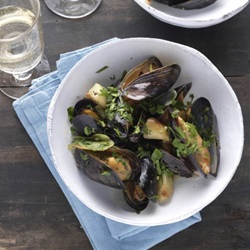As a global non-profit, the MSC works with scientists, conservation groups and seafood industry to establish the world's most recognized standard for seafood sustainability. When fisheries and companies meet the MSC Standard, they can use the MSC blue fish label to show seafood lovers when seafood comes from a well-managed, sustainable source that works hard to protect the marine environment.
So when you buy seafood with the MSC blue fish label, you know it's sustainably sourced and is good for you and the ocean too. Speaking of 'good for you', seafood is indeed a healthy, versatile protein choice, but we wanted to dig a little deeper to find out exactly what it is that makes seafood so healthy. So, we sat down with Seafood Nutrition Partnership (SNP) Communications Manager and Registered Dietitian Valerie Agyeman for a little Q&A on the health benefits of seafood. Here’s what we learned.Q&A with the Seafood Nutrition Partnership
Q: Why does SNP recommend eating seafood twice a week?
Q: What are omega-3s? What seafood is highest in omega-3s?
A: Omega-3s are a family of essential fatty acids that play important roles in your body and may provide a number of health benefits. As your body cannot produce them on its own, you must get them from your diet.
 The three main types are ALA, EPA, and DHA. ALA is plentiful in the food system, in foods such as walnuts and many oils. EPA and DHA, found naturally only in seafood, are the omega-3s with the most benefits for brain and heart health.
The three main types are ALA, EPA, and DHA. ALA is plentiful in the food system, in foods such as walnuts and many oils. EPA and DHA, found naturally only in seafood, are the omega-3s with the most benefits for brain and heart health.When it comes to fish with the highest levels of omega-3s, there’s salmon, sardines, swordfish, trout and mackerel to name a few. And, don’t forget shellfish, too - oysters, crab, mussels and squid all provide at least 500mg of omega-3s EPA and DHA per serving.
Q: What are some lesser known health benefits of seafood?
A: Seafood is like a multivitamin for your brain. Fish is more than just an excellent source of lean protein and essential omega-3s, it provides other vitamins and minerals important for overall health.
We normally hear that eating seafood is beneficial to heart health, which is true, but seafood is also beneficial to other parts of the body. It has benefits for your brain and mental health, diabetes prevention and care, pregnancy and infant/child nutrition, and healthy aging. The list goes on, and it’s good to know that seafood has a positive impact on your body at every stage of the life cycle.
Q: Are there nutritional differences between fresh and frozen seafood? Are there nutritional differences between whole fish/fillets and tinned/preserved seafood?
A: It might seem that fresh fish would be a healthier choice than frozen, the truth is that
0aec738a1194403597489071722b2768.tmb-thumb250.jpg?Culture=en-US&sfvrsn=acf72323_4) both fresh and frozen fish are both healthy choices, as long as you store and prepare them properly.
both fresh and frozen fish are both healthy choices, as long as you store and prepare them properly.Freezing doesn't reduce the nutritional content of fish, in fact it seals in the freshness. The same goes for canned fish - it is cooked at its peak freshness and canned right away, so there is no degradation of nutrients. Overall, for all types of seafood, it is important to check the label for added salt and trans-fat content.
Q: What is a healthy way to cook fish? What oils should people use when cooking?
A: A few healthier cooking methods for fish include baking or roasting, grilling, steaming, and poaching. These methods do not require additional oil to cook with.
For pan-searing or any other methods that add oil, which we suggest eating in moderation - extra light olive oil and sunflower oil are great options. They have a high smoke point and heart-healthy unsaturated fats .
--
Speaking of cooking fish, check out our recipe page for more inspiration!
